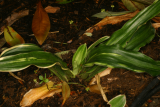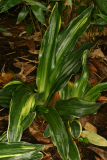Additional notes (click to expand)
Commemorative
Named by Roth for his friend Michael Rohde (1782–1812). Rohde was a physician and botanist from Bremen whose doctoral thesis was on quinine, He died of typhoid in 1812, aged 30 (Oakeley, 2012).
Oakeley, Dr. Henry F. (2013). Wellcome Library notes.
link
Medicinal
It is used in Chinese medicine but is regarded elsewhere as being poisonous and best avoided.
Oakeley, Dr. Henry F. (2013). Wellcome Library notes.
link
In traditional herbal medicine:
The leaves and the roots are depurative, diuretic and febrifuge[61, 147].They are used in the treatment of abscesses, boils, sore throat etc[147, 218]. The roots are used externally as a poultice and internally as a heart and nerve tonic[218]. The plant shows cardiac activity, rather like digitoxin (in Digitalis purpurea)[218].
http://www.pfaf.org, https://pfaf.org/user/Plant.aspx?LatinName=Rohdea+japonica
Nomenclature
It is a monotypic genus known as omoto in Japan, meaning ‘evergreen’. It is used in Chinese medicine but is regarded elsewhere as being poisonous and best avoided. Named by Roth for his friend Michael Rohde (1782–1812). Rohde was a physician and botanist from Bremen whose doctoral thesis was on quinine, He died of typhoid in 1812, aged 30 (Oakeley, 2012).
Oakeley, Dr. Henry F. (2013). Wellcome Library notes.
link
Other use
It is regarded as a symbol of long life and good fortune; Ieyasu Tokugawa, the first Shogun of the Edo period (1603–1867), took three plants with him to Edo Castle to ensure happy fortune. Its cultivation became such a craze in Japan that its sale was banned in 1852, but it remains hugely popular with 600 cultivars registered with the Japan Rohdea Society. It is used in Chinese medicine but is regarded elsewhere as being poisonous and best avoided. Named by Roth for his friend Michael Rohde (1782–1812). Rohde was a physician and botanist from Bremen whose doctoral thesis was on quinine, He died of typhoid in 1812, aged 30 (Oakeley, 2012).
Oakeley, Dr. Henry F. (2013). Wellcome Library notes.
link
Geographical distribution
- Asia-Temperate, China
- Asia-Temperate, Eastern Asia, Japan
Rohdea japonica (Thunb.) Roth
Family: ASPARAGACEAEGenus: Rohdea
Species: japonica (Thunb.) Roth
Common names: Omoto
Distribution summary: China, Japan
Habit: Perennial
Habitat: Woods, thickets, banks
Garden status: Currently grown
Garden location: Far East (L)
Flowering months: March, April
Reason for growing: Medicinal, other use

